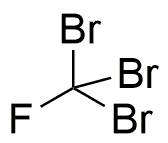Tribromofluoromethane is widely utilized in research focused on:
- Fire Suppression: This compound is used in specialized fire extinguishing systems due to its effectiveness in suppressing flames, particularly in areas where water damage must be minimized, such as in data centers.
- Refrigerants: It serves as a refrigerant in certain cooling applications, providing efficient heat transfer properties that are beneficial in industrial refrigeration systems.
- Analytical Chemistry: In laboratories, it is employed as a solvent and reagent in various analytical procedures, helping to enhance the accuracy of chemical analyses.
- Organic Synthesis: The compound is utilized in the synthesis of other brominated compounds, which are important in pharmaceuticals and agrochemicals, offering a pathway to develop new drugs and pesticides.
- Environmental Studies: It is used in studies assessing the impact of halogenated compounds on the environment, aiding researchers in understanding atmospheric chemistry and pollution control.
General Information
Properties
Safety and Regulations
Applications
Tribromofluoromethane is widely utilized in research focused on:
- Fire Suppression: This compound is used in specialized fire extinguishing systems due to its effectiveness in suppressing flames, particularly in areas where water damage must be minimized, such as in data centers.
- Refrigerants: It serves as a refrigerant in certain cooling applications, providing efficient heat transfer properties that are beneficial in industrial refrigeration systems.
- Analytical Chemistry: In laboratories, it is employed as a solvent and reagent in various analytical procedures, helping to enhance the accuracy of chemical analyses.
- Organic Synthesis: The compound is utilized in the synthesis of other brominated compounds, which are important in pharmaceuticals and agrochemicals, offering a pathway to develop new drugs and pesticides.
- Environmental Studies: It is used in studies assessing the impact of halogenated compounds on the environment, aiding researchers in understanding atmospheric chemistry and pollution control.
Documents
Safety Data Sheets (SDS)
The SDS provides comprehensive safety information on handling, storage, and disposal of the product.
Product Specification (PS)
The PS provides a comprehensive breakdown of the product’s properties, including chemical composition, physical state, purity, and storage requirements. It also details acceptable quality ranges and the product's intended applications.
Certificates of Analysis (COA)
Search for Certificates of Analysis (COA) by entering the products Lot Number. Lot and Batch Numbers can be found on a product’s label following the words ‘Lot’ or ‘Batch’.
*Catalog Number
*Lot Number
Certificates Of Origin (COO)
This COO confirms the country where the product was manufactured, and also details the materials and components used in it and whether it is derived from natural, synthetic, or other specific sources. This certificate may be required for customs, trade, and regulatory compliance.
*Catalog Number
*Lot Number
Safety Data Sheets (SDS)
The SDS provides comprehensive safety information on handling, storage, and disposal of the product.
DownloadProduct Specification (PS)
The PS provides a comprehensive breakdown of the product’s properties, including chemical composition, physical state, purity, and storage requirements. It also details acceptable quality ranges and the product's intended applications.
DownloadCertificates of Analysis (COA)
Search for Certificates of Analysis (COA) by entering the products Lot Number. Lot and Batch Numbers can be found on a product’s label following the words ‘Lot’ or ‘Batch’.
*Catalog Number
*Lot Number
Certificates Of Origin (COO)
This COO confirms the country where the product was manufactured, and also details the materials and components used in it and whether it is derived from natural, synthetic, or other specific sources. This certificate may be required for customs, trade, and regulatory compliance.


